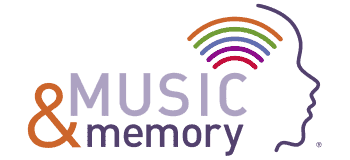
It was a stunning awakening. For eight months, the woman had stopped participating in art therapy. She used to enjoy painting with watercolors, alongside other women in her group at Terracina Grand, an Alzheimer’s community in Naples, Fla. But as her dementia worsened, she had become more and more agitated, sometimes swinging and hitting her caregivers.
Not willing to give up, Angel Duncan, an experienced art therapist, as well as Director of Education and a clinician at the Neuropsychiatric Research Center of Southwest Florida, decided to try a different tack.
Maybe, she thought, the right music could help the woman to express herself with paint once again. Art therapy is widely used to help individuals with Alzheimer’s, other forms of dementia and a host of physical, emotional and mental challenges to tap inner creativity as a means to express feelings and reduce stress, among other benefits.
Although Duncan has often brought age-appropriate background music into art therapy sessions for an added spark of inspiration, this time she placed a set of headphones on the woman, so she could hear her personal musical favorites.
“She sat with her headphones on, dancing in her seat, smiling,” says Duncan. “When I asked what color the music was, she said, ‘Well, the beginning of it is red.’ She grabbed the brush and painted a little red tree.”
Enhanced Focus and Self-Expression
To Duncan’s amazement, the woman remained immersed in her painting for the entire hour. Afterwards, they processed what the painting meant. While her speech was fragmented, she was able to communicate that the image was a plant, like the ones she used to have all over her home.
And this was not the only one in the group to benefit from a personalized playlist. Duncan says another woman who always falls asleep and appears indifferent was suddenly wide awake, fully engaged with everyone else, painting bright splashes of color: “She said the purple streak was her favorite. It made her happy.” The key, once again, was musical favorites on an iPod, thanks to Terracina Grand’s Music & Memory program.
“I’ve been doing music and art for years with this population,” says Duncan, who travels nationwide, teaching creative applications of art therapy to fellow professionals. “But their own, personalized playlist pulls the colors from inside like no other.”
Greatest Benefits for Those with Advanced Alzheimer’s and Other Dementias
One of the biggest challenges in art therapy is getting people to open up and trust that they can paint or draw. While there are different approaches—some art therapists prefer to create a quiet, “sacred space” where participants can focus and allow their thoughts and feelings to flow to the surface without any distractions—Duncan has always combined music with art.
“I can’t tell you how many times I’ve had to rely on music to get people to open up and be creative,” she says. “People will say, ‘I can’t paint, I’m not an artist.’ Maybe we’d have Elvis playing. I’d ask, ‘What color is the music?’ They’d say it was a happy color and paint a red ball, or this part is slower and paint blue lines. I realized this was it. With music, you can tap into something deeper.”
Duncan acknowledges that art therapy can enable people to express themselves without any music—and for some individuals, music can actually be triggering and stressful. But for persons with advanced Alzheimer’s and other late stage dementias, she says, “the personalized music and headphones are essential.”
“Music Lights Up the Entire Brain”
She adds, “I’ve had some amazing art therapy sessions combined with the Music & Memory program.” When Duncan asked one participant what memories were tied to her favorite music as she painted, the woman removed her headphones and said it reminded her of her high school.
“She started painting a tree with a tire swing and herself and told me a whole story about her high school days,” says Duncan. Another woman, listening to the song that she danced to at her wedding, drew a picture of herself in a tutu with her husband.
An added advantage: The paintings inspired by memories tapped by musical favorites become a way for family to see into their loved one’s world—especially when words are no longer easily accessed.
“The painting becomes a snapshot of what they’re remembering in the moment,” explains Duncan. “Music lights up the entire brain. It gets the dopamine flowing and gives them the energy to be creative. They’re no longer sitting there with a blank piece of paper, wondering what to do—or completely blocked.”
Founded in 2010, MUSIC & MEMORY® is a non-profit organization that brings personalized music into the lives of people with cognitive or physical challenges through digital music technology, vastly improving quality of life.
